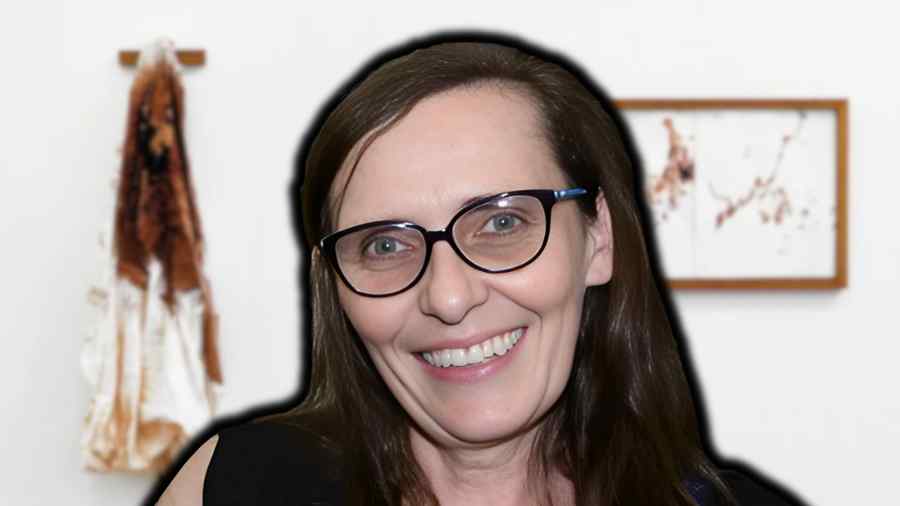Karin Lambrecht: The Visionary Brazilian Artist Redefining Spiritual Abstraction

The name Karin Lambrecht stands tall among contemporary artists who transcend the conventional boundaries of painting and sculpture. Born in Porto Alegre, Brazil, in 1957, Lambrecht has spent decades forging a deeply personal and spiritual path in the world of art. Her creations are more than mere visual experiences; they are emotional and philosophical encounters that explore the relationships between life, nature, and spirituality. Known for using unconventional materials such as rainwater, earth, and even animal blood, her art delves into the raw essence of human existence and the invisible threads that connect all living beings.
Early Life and Education
Karin Lambrecht began her artistic journey in her hometown of Porto Alegre, where she studied at the Instituto de Artes of the Universidade Federal do Rio Grande do Sul (UFRGS). Her passion for experimentation and curiosity for materiality became evident during her formative years. Under the mentorship of influential Brazilian artists like Danúbio Gonçalves, she developed an understanding of lithography and other printmaking techniques. However, even at that early stage, her interest gravitated towards the physical and spiritual nature of materials rather than their aesthetic form alone.
In the 1980s, Lambrecht became associated with the “Geração 80” – a pivotal movement that marked the rebirth of painting in Brazil. This generation was defined by its emotional intensity, vivid colours, and freedom from traditional artistic constraints. Karin’s work during this period stood out for its fearless use of symbolism and its refusal to separate art from the human condition.
Artistic Philosophy
Lambrecht’s art is deeply philosophical. Her approach is not to depict beauty but to uncover truth. She believes that every material—whether pigment, cloth, or soil—has its own spiritual presence. For her, painting is not only a visual act but also a meditative process. She once described her practice as “a form of dialogue between the visible and the invisible.”
Her fascination with the cycles of life and death, growth and decay, is central to her work. By incorporating organic elements such as ashes, charcoal, and blood, she questions the fragility of life and the persistence of memory. These raw materials carry both physical and emotional weight, turning her canvases into sacred spaces that embody the passage of time and the transformation of matter.
Materiality and Technique
Karin Lambrecht is known for rejecting traditional canvases. Instead, she constructs her surfaces from torn, stitched, or layered fabrics. Each piece feels alive, textured, and deeply tactile. The act of sewing and mending her canvases symbolises healing—an attempt to reconnect what the world has broken.
Her colour palette is another defining feature. She frequently uses vibrant reds and profound blues, colours that carry strong emotional and spiritual associations. Red often symbolises vitality and sacrifice, while blue evokes introspection and transcendence. She creates her own pigments from natural substances, ensuring that every shade bears a direct connection to the Earth.
In some works, Lambrecht integrates handwritten words, abstract crosses, and faint outlines of the human body. These recurring symbols suggest the coexistence of body and spirit, faith and doubt. Her compositions might appear abstract at first glance, but they carry an undeniable sense of sacredness—a silent prayer embedded in pigment and fabric.
Spiritual Dimension
To understand Karin Lambrecht is to recognise her deep spiritual awareness. Her art explores themes of faith, mortality, and transcendence without confining itself to any one religion. She often reflects on the biblical notion of dust—“for dust thou art, and unto dust shalt thou return”—to remind the viewer of humanity’s eternal bond with the earth.
Rather than glorifying divinity, she seeks to find holiness in the everyday. Her works reveal that spirituality is not distant or abstract; it is present in every grain of soil, every drop of rain, every trace of blood. In this way, her paintings become meditative spaces where the viewer can confront both the fragility and the sanctity of life.
Evolution of Style
Lambrecht’s style has evolved significantly over the years. Her early works were bold and gestural, full of expressive brushstrokes and vivid contrasts. As her career progressed, she shifted toward more contemplative and atmospheric compositions. The energy of her early years matured into a more profound stillness, yet her emotional intensity never diminished.
This evolution reflects her personal and philosophical growth. Having lived in both Brazil and Europe, Lambrecht absorbed diverse cultural influences while maintaining her South American identity. Her more recent works, often created in her UK studio, continue to explore light, transparency, and the dialogue between inner and outer worlds.
Major Exhibitions and Recognition
Karin Lambrecht’s contributions to contemporary art have been widely recognised. She has exhibited in major galleries and museums across Brazil, Europe, and the United States. Some of her most celebrated exhibitions include Seasons of the Soul and The Intimacy of Light, presented at Galeria Nara Roesler. These shows highlighted her ongoing fascination with transformation and the human spirit.
Her art has also been featured in the Bienal de São Paulo, one of Latin America’s most prestigious art events, and in numerous institutional exhibitions that examine post-modern spirituality and material experimentation. Critics often describe her work as “sacred abstraction,” acknowledging her ability to merge the physical with the metaphysical through minimal yet powerful gestures.
Themes of Nature and Humanity
Nature is not merely a backdrop in Lambrecht’s art—it is a living participant. She frequently uses natural elements such as rainwater, branches, and soil to create textures and tones that echo the world’s natural rhythms. By allowing environmental forces to shape her paintings, she relinquishes control and invites the unpredictable beauty of nature into her creative process.
At its core, her work speaks of humanity’s interdependence with the natural world. She reminds us that we are not separate from nature but an extension of it. Her paintings, often layered and weathered, resemble the earth itself—eroded, patched, yet profoundly alive.
Influence and Legacy
Over the decades, Karin Lambrecht has influenced a new generation of artists who see painting not just as a visual form but as a spiritual practice. Her courage to use nontraditional materials and her commitment to authenticity have inspired many young creators to explore their own sense of truth.
Art historians frequently cite her as one of the most important female voices in contemporary Brazilian art. Her ability to merge the sacred and the material, the personal and the universal, makes her oeuvre timeless. Beyond aesthetics, her work invites reflection—a rare quality in today’s fast-paced art world.
Critical Reception
Critics often emphasise the poetic intensity of Lambrecht’s work. They note her ability to make absence feel tangible, silence feel audible. Her art has been described as “ritualistic,” “meditative,” and “viscerally human.” The emotional resonance of her paintings often leaves viewers contemplative long after they have left the gallery space.
What distinguishes Lambrecht is not only her technical skill but also her moral and emotional honesty. She paints as one who feels deeply, questions constantly, and seeks endlessly. Her art does not offer easy answers; instead, it opens pathways to introspection.
Personal Life and Continuing Work
Although Karin Lambrecht divides her time between Brazil and the United Kingdom, her connection to her homeland remains profound. The Brazilian landscape—its light, soil, and humidity—continues to inspire her palette and choice of materials.
Even in her later years, she remains committed to experimentation. Her recent series explores the translucency of fabric and the concept of “painting with air.” Through delicate layering and subtle tones, she invites the viewer into a world of serenity and reflection.
Conclusion
Karin Lambrecht’s artistic journey is a testimony to the power of authenticity, faith, and transformation. Her art transcends borders, languages, and definitions. It is deeply human yet cosmic in scope—rooted in the soil but reaching toward the divine.
By turning simple materials into vessels of meaning, she challenges our understanding of what art can be. Her canvases breathe, bleed, and pray; they remind us that creation and destruction are inseparable forces in the universe.



